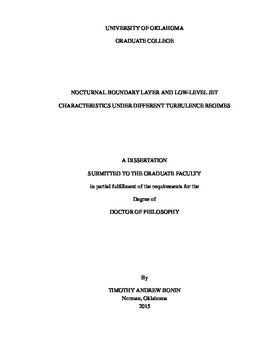| dc.description.abstract | The intensity, extent, and continuity of turbulence in the nocturnal stable boundary layer (SBL) is governed by many interacting processes and features. Generally, SBLs can be grouped into two broad categories: weakly stable and very stable. While the weakly SBL is relatively well understood and can be described by Monin-Obukhov similarity theory or other local scaling laws, the very SBL is difficult to characterize and parameterize. It is also difficult to predict which type of SBL will form nocturnally as differentiating characteristics of the two regimes are not well-known. Furthermore, nocturnal low-level jets (LLJs) often form around sunset, particularly in the Great Plains region of the United States, and generally interact with the nocturnal SBL. These relationships between LLJs and the SBL are currently not well-understood.
To characterize turbulence within the SBL, vertical velocity variances estimated from Doppler lidar (DL) observations are used, which first need to be validated. To accomplish this, DL-derived values of vertical velocity variance are directly compared with those from sonic anemometer observations installed on a 300-m tower during the Lower Atmospheric Thermodynamics and Turbulence Experiment (LATTE), which was conducted in February--April 2014 at the Boulder Atmospheric Observatory . An autocovariance method of removing noise from the DL observations is used, which is shown to improve measurements of vertical velocity variance. In addition to removing noise, this method can also correct for underestimates of variance due to time and volume averaging of the DL. Generally, the DL-derived variance values tend to agree closely with those from the sonic anemometers after the autocovariance correction is applied.
To investigate the SBL in detail, Doppler lidar, sonic anemometer, Atmospheric Emitted Radiance Interferometer (AERI), and radiosonde measurements that were collected during the Lower Atmospheric Boundary Layer Experiment (LABLE-I) are analyzed. LABLE-I was a multi-institutional field campaign that took place from 18 September to 13 November 2012 at the Southern Great Plains site in north central Oklahoma. During the experiment, LLJs were frequently observed and interacted with both weakly and very stable SBLs. Within the weakly stable boundary layer, turbulence tended to be generated at the surface and transported upward, and no strong surface-based inversion formed overnight. When a strongly stable boundary layer formed, mixing was either generated near a LLJ or at the surface and remained very weak overnight. On these nights, a strong surface based inversion formed and slowly grew throughout the night.
LLJs also evolved differently depending on if a weakly or strongly SBL formed. With a strongly SBL, LLJs tended to increase in both strength and height overnight, often corresponding to a gradual increase in synoptic-scale forcing. LLJs that occurred with a weakly SBL generally remained constant in height overnight, and reached a peak in strength around midnight. These LLJs often had approximately constant large-scale forcing overnight, thus their evolution more closely resembled what is expected by an inertial oscillation. | en_US |
